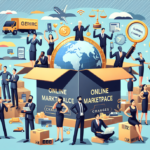Fulfillment by Amazon (FBA) vs Outerspace: Choosing the Right Fulfillment Service for Your E-Commerce Business
Running an e-commerce business involves numerous challenges, particularly in managing inventory and shipping. Fulfillment by Amazon (FBA) and Outerspace are two prominent options for outsourcing these tasks. This comprehensive guide examines the differences between FBA and Outerspace to help you determine which service aligns best with your business needs.
The Basics of Fulfillment by Amazon (FBA) and Outerspace
Fulfillment by Amazon (FBA) is a service offered by Amazon that enables sellers to store their products in Amazon's expansive network of warehouses. When a customer places an order, Amazon manages the picking, packing, shipping, customer service, and returns processes. This comprehensive service allows sellers to leverage Amazon's robust logistics infrastructure and Prime shipping benefits.
Outerspace, a newer entrant in the fulfillment industry, provides similar services but with distinct differences. Outerspace allows businesses to store products in their warehouses and handles the picking, packing, and shipping of orders. However, unlike FBA, Outerspace does not include customer service or returns management as part of their standard offerings.
One significant advantage of Outerspace is the flexibility it offers in terms of shipping and packaging options. Sellers can choose their preferred carriers and packaging materials, which is particularly beneficial for those with specific branding or packaging requirements. Additionally, Outerspace provides flexible pricing models, offering options between per-item fees or monthly storage fees.
Key Differences Between FBA and Outerspace
- Customer Service: FBA includes customer service and returns handling, whereas Outerspace does not.
- Customization: Outerspace offers more customizable shipping and packaging options compared to FBA.
- Pricing Models: Outerspace provides flexible pricing options, allowing sellers to choose between different fee structures.
The Advantages and Disadvantages of Using Fulfillment by Amazon (FBA)
FBA is a favored choice among e-commerce sellers due to its comprehensive service offerings. However, it comes with both advantages and disadvantages:
Advantages of FBA
- Prime Eligibility: Products fulfilled by FBA are eligible for Prime shipping, which can lead to increased sales and faster shipping times. According to a Statista report, Amazon Prime has over 200 million subscribers worldwide, enhancing product visibility and attractiveness.
- Customer Service and Returns: FBA manages customer inquiries and returns, saving sellers time and resources.
Disadvantages of FBA
- Cost: FBA fees can accumulate, especially for businesses with a large number of products or high storage needs.
- Control Over Shipping: Sellers have limited control over the shipping process, which can sometimes lead to delays and affect customer satisfaction.
- Handling Unique Products: FBA may not be ideal for products that are unique, fragile, or require special handling.
- Brand Differentiation: Since many sellers use FBA, it can be challenging to differentiate your products from competitors.
- Packaging Limitations: Customization of packaging and labeling is limited, which can impact brand image.
Carefully weighing these pros and cons is essential in determining whether FBA is the optimal fulfillment solution for your business.
Why Outerspace May Be a Better Option Than Fulfillment by Amazon (FBA)
Outerspace presents several advantages over FBA that may make it a more suitable choice for certain businesses:
Cost Efficiency
Outerspace often offers lower storage and fulfillment fees compared to FBA, allowing businesses to realize significant cost savings over time. This is particularly advantageous for businesses with large inventories or lower-margin products.
Personalized Service
Outerspace adopts a more personalized approach to fulfillment, tailoring services to meet the specific needs of each business. Their warehouses are equipped to handle unique and fragile items, ensuring that products are packaged and managed with extra care.
Commitment to Sustainability
Outerspace emphasizes sustainability by utilizing eco-friendly packaging materials and implementing energy-efficient practices in their warehouses. This commitment appeals to environmentally conscious customers and aligns with growing consumer demand for sustainable business practices.
Customizable Packaging Options
Businesses can customize their packaging with their branding and personal touches when using Outerspace. This customization helps in differentiating the brand and enhancing the customer experience.
Downsides of Using Outerspace
- No Included Customer Service: Outerspace does not manage customer service or returns, which means businesses need to handle these aspects independently.
- Prime Shipping Unavailable: Without access to Prime shipping, businesses may miss out on customers who prioritize fast shipping options.
The Cost Comparison: Fulfillment by Amazon (FBA) vs Outerspace
Cost is a critical factor when choosing a fulfillment service. Generally, Outerspace offers more competitive storage and fulfillment fees compared to FBA. However, the actual costs can vary based on specific business needs such as product size, volume, and storage duration.
FBA Costs
- Fulfillment Fees: Based on size and weight of the product.
- Storage Fees: Monthly and long-term storage fees apply.
Outerspace Costs
- Flexible Pricing: Choose between per-item fees or monthly storage fees, providing more budget control.
- Lower Overall Fees: Typically lower than FBA for similar services.
Additional Cost Considerations
- Customer Base and Brand Recognition: FBA benefits from Amazon's vast customer base and strong brand recognition, potentially leading to increased sales.
- Service Inclusions: While FBA includes customer service and returns handling, Outerspace may require additional resources for these services.
A detailed cost analysis tailored to your business model is essential to make an informed decision between FBA and Outerspace.
How to Decide Which Fulfillment Option Is Right for Your Business
Selecting the appropriate fulfillment service requires a strategic evaluation of various factors:
Product Niche and Handling Requirements
If your products are unique, fragile, or require special handling, Outerspace may be the better choice. For standard products with high turnover, FBA could be more advantageous.
Fees and Service Offerings
Evaluate the comprehensive service packages and fee structures of both FBA and Outerspace. FBA offers a full suite of services at a higher cost, while Outerspace provides more affordable options with fewer included services.
Customer Location
Consider where your customers are predominantly located. Choosing a fulfillment center closer to your main customer base can reduce shipping costs and delivery times, enhancing customer satisfaction and boosting sales.
Pros and Cons of Outsourcing Your Fulfillment Needs to a Third-Party Provider
Outsourcing fulfillment can offer several benefits but also comes with potential drawbacks:
Pros
- Time and Cost Savings: Outsourcing frees up resources, allowing you to focus on core business activities.
- Efficiency: Third-party providers often offer faster and more reliable shipping compared to in-house fulfillment.
Cons
- Reduced Control: Outsourcing means less direct control over the fulfillment process, which can lead to delays and affect customer satisfaction.
- Brand Risk: Selecting an inappropriate fulfillment provider can negatively impact your brand reputation and customer experience.
Ensuring that the chosen third-party provider aligns with your brand values and maintains high service quality is crucial for maintaining a positive reputation.
How to Optimize Your Fulfillment Process for Maximum Efficiency and Profitability
Optimizing your fulfillment process is essential for enhancing operational efficiency and profitability, regardless of the provider you choose:
- Regular Inventory Reviews: Monitor inventory levels regularly and adjust storage and fulfillment needs to prevent overstocking or stockouts.
- Streamlined Shipping Processes: Implement automation tools to streamline shipping workflows, saving time and reducing errors.
- Effective Packaging: Use appropriate packaging materials and sizes to minimize shipping costs and prevent product damage.
- Eco-Friendly Options: Adopt sustainable packaging solutions to appeal to environmentally conscious customers.
- Prioritize Customer Satisfaction: Provide accurate tracking information, offer easy returns and exchanges, and ensure products arrive in excellent condition to build customer loyalty and encourage repeat business.
The Future of E-Commerce Fulfillment: A Look at Emerging Trends and Technologies
The e-commerce fulfillment landscape is continually evolving, driven by advancements in technology and shifting consumer expectations. Key emerging trends include:
- Robotics and Automation: The integration of robotics and automation in fulfillment centers is streamlining processes, increasing efficiency, and reducing error rates. For example, Amazon's use of Kiva robots has significantly optimized their warehouse operations.
- Sustainability: There is a growing emphasis on eco-friendly packaging and sustainable fulfillment practices to meet consumer demand for environmentally responsible businesses.
- Market Expansion: The entry of new players into the fulfillment market is fostering innovation, leading to the development of more specialized and versatile fulfillment solutions tailored to diverse e-commerce needs.
Tips for Successfully Managing Your Inventory with Fulfillment by Amazon (FBA) or Outerspace
Effective inventory management is critical for successful e-commerce fulfillment. Whether utilizing FBA or Outerspace, the following strategies can enhance inventory management:
- Regular Sales Data Analysis: Analyze sales data routinely to adjust inventory levels based on trends, preventing overstocking or stockouts.
- Utilize Inventory Management Software: Implement software solutions to automate and streamline inventory tracking, ensuring real-time visibility and accurate stock levels.
Understanding the Impact of COVID-19 on E-Commerce Fulfillment and What You Can Do About It
The COVID-19 pandemic had profound effects on the e-commerce fulfillment industry, introducing several challenges:
- Supply Chain Disruptions: The pandemic caused significant delays and increased costs due to disruptions in global supply chains.
- Shipping Delays: Increased demand and logistical bottlenecks led to longer delivery times, adversely affecting customer satisfaction.
- Inventory Shortages: Fluctuations in demand and supply chain issues complicated inventory management.
To effectively navigate these challenges, businesses should:
- Stay Informed: Keep abreast of the latest industry trends and regulatory changes to adapt swiftly to evolving conditions.
- Maintain Flexibility: Adopt adaptable fulfillment strategies that can respond to unexpected disruptions and changes in demand.
Common Mistakes to Avoid When Using Fulfillment by Amazon (FBA) or Outerspace
Avoiding common pitfalls is essential to ensure smooth fulfillment operations and prevent unnecessary costs:
- Poor Preparation and Packaging: Inadequately preparing and packaging products can lead to damage, increased returns, and dissatisfied customers.
- Overlooking Fees and Charges: Failing to thoroughly review and understand all fees and charges can result in unexpected costs, affecting profitability.
- Neglecting Provider Audits: Regularly auditing your fulfillment provider's performance ensures they meet your service and quality standards, maintaining brand integrity.
How to Implement an Effective Shipping Strategy with Fulfillment by Amazon (FBA) or Outerspace
A robust shipping strategy is pivotal for saving time and money while enhancing customer satisfaction. Consider the following approaches:
- Offer Fast and Reliable Shipping Options: Providing expedited shipping services, such as Amazon Prime or express shipping through Outerspace, can attract more customers seeking quick delivery.
- Leverage Automation Tools: Utilize automation tools to streamline shipping processes, reducing the likelihood of errors and delays.
Case Studies: Real-Life Examples of Businesses That Have Successfully Used Fulfillment by Amazon (FBA) or Outerspace
Numerous businesses have effectively leveraged FBA or Outerspace to optimize their fulfillment processes and enhance their profitability:
- Business X: By utilizing FBA, Business X significantly reduced shipping times and improved customer satisfaction, leading to a 25% increase in sales within six months.
- Business Y: Leveraging Outerspace's lower fees and personalized service, Business Y achieved a 30% reduction in fulfillment costs and enhanced brand loyalty through customized packaging.
Conclusion: Which Is the Better Option for Your Business?
The choice between Fulfillment by Amazon (FBA) and Outerspace hinges on your specific business requirements and objectives. Both services present unique advantages and challenges:
- FBA: Best suited for businesses seeking comprehensive fulfillment services, Prime eligibility, and increased visibility through Amazon's extensive platform.
- Outerspace: Ideal for businesses looking for cost-effective solutions, customizable packaging, and a personalized fulfillment approach.
Ultimately, regularly evaluating your fulfillment processes and adapting your strategies as your business evolves will ensure that your fulfillment operations remain efficient and profitable, regardless of the provider you choose.






















